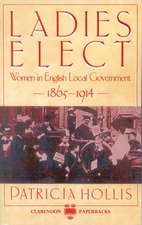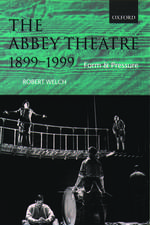Locating Privacy in Tudor London
Autor Lena Cowen Orlinen Limba Engleză Paperback – 7 ian 2010
| Toate formatele și edițiile | Preț | Express |
|---|---|---|
| Paperback (1) | 335.34 lei 31-37 zile | |
| OUP OXFORD – 7 ian 2010 | 335.34 lei 31-37 zile | |
| Hardback (1) | 618.14 lei 31-37 zile | |
| OUP OXFORD – 13 dec 2007 | 618.14 lei 31-37 zile |
Preț: 335.34 lei
Preț vechi: 410.38 lei
-18% Nou
Puncte Express: 503
Preț estimativ în valută:
64.19€ • 69.75$ • 53.95£
64.19€ • 69.75$ • 53.95£
Carte tipărită la comandă
Livrare economică 11-17 aprilie
Preluare comenzi: 021 569.72.76
Specificații
ISBN-13: 9780199577385
ISBN-10: 0199577382
Pagini: 392
Ilustrații: 45 black-and-white halftones
Dimensiuni: 157 x 233 x 18 mm
Greutate: 0.54 kg
Editura: OUP OXFORD
Colecția OUP Oxford
Locul publicării:Oxford, United Kingdom
ISBN-10: 0199577382
Pagini: 392
Ilustrații: 45 black-and-white halftones
Dimensiuni: 157 x 233 x 18 mm
Greutate: 0.54 kg
Editura: OUP OXFORD
Colecția OUP Oxford
Locul publicării:Oxford, United Kingdom
Recenzii
Review from previous edition Locating Privacy in Tudor London ranges over boundaries, ground plans, surveys,...wills, inventories and the "great rebuilding" of England between 1570 and 1640...Orlin pursues her subject from many directions...
This book is full of human stories which bring to life Tudor society in London and beyond. It illustrates with clarity how information was garnered for the prosecution of those suspected of treason, heresy, crime or immorality.
Oxford University Press have produced an impeccable volume, with copious and beautifully reproduced illustrations; in a period when careful editing seems to be going out of fashion, even notes at the bottom of the page are a matter for congratulation... this is a book which should attract a readership beyond its apparent scholarly specialization; it is well-written and brings the past to life.
Lena Cowen Orlin re-assesses the issue of privacy and concludes that far from this being the uncomplicated right of an ever-increasing number of individuals, it was a site of conflict and anxiety in Tudor England. With a mass of new primary evidence she carefully and scrupulously challenges received ideas about the 'Great Rebuilding', the nature of private space and the roles of men and women. The physical fabric of the world she examines, such as changes to domestic building, urban boundary disputes and even the role of peep-holes in the fittings of the interior, opens up new perspectives on these people's lives. A huge range of historians, those of social politics, of architecture, of representation through painting, and of the urban environment, will be gripped by this book.
Only very occasionally does a book appear that causes the reader to think about a historical period in a fresh new manner. Lena Cowen Orlin's Locating Privacy is one such text. It is beautifully written and thoroughly researched. With the interlocking chapters that present in rich detail the life of Alice Barnham, wife of draper Francis Barnham and committed Protestant and London silkwoman in her own right, with brilliant discussions of physical space and notions of privacy in the political culture of early modern England, this is a book to be celebrated. By the end of her study, Orlin has found a way to inextricably tie her two themes together, enriching them both.
Lena Orlin is one of our greatest Renaissance scholars. Her superb new book uses rich archival research to make us rethink our most fundamental assumptions about privacy, gender, and identity and to show us just how much we can know about those supposedly 'hidden from history.'
In Locating Privacy, Lena Cowen Orlin has redefined our understanding of early modern material culture, telling a story not only about objects and spaces, but also about the people who lived with and within them. Moving easily among such diverse sources as paintings, peepholes, building plans and legal records, Orlin takes us beyond Aries, Hoskins and Girouard to re-claim privacy as a central arena through which social changes were resisted, accommodated and acknowledged. A triumph of interdisciplinary studies, this is a book that will be admired by historians, literary critics, art historians and scholars of gender.
This book is full of human stories which bring to life Tudor society in London and beyond. It illustrates with clarity how information was garnered for the prosecution of those suspected of treason, heresy, crime or immorality.
Oxford University Press have produced an impeccable volume, with copious and beautifully reproduced illustrations; in a period when careful editing seems to be going out of fashion, even notes at the bottom of the page are a matter for congratulation... this is a book which should attract a readership beyond its apparent scholarly specialization; it is well-written and brings the past to life.
Lena Cowen Orlin re-assesses the issue of privacy and concludes that far from this being the uncomplicated right of an ever-increasing number of individuals, it was a site of conflict and anxiety in Tudor England. With a mass of new primary evidence she carefully and scrupulously challenges received ideas about the 'Great Rebuilding', the nature of private space and the roles of men and women. The physical fabric of the world she examines, such as changes to domestic building, urban boundary disputes and even the role of peep-holes in the fittings of the interior, opens up new perspectives on these people's lives. A huge range of historians, those of social politics, of architecture, of representation through painting, and of the urban environment, will be gripped by this book.
Only very occasionally does a book appear that causes the reader to think about a historical period in a fresh new manner. Lena Cowen Orlin's Locating Privacy is one such text. It is beautifully written and thoroughly researched. With the interlocking chapters that present in rich detail the life of Alice Barnham, wife of draper Francis Barnham and committed Protestant and London silkwoman in her own right, with brilliant discussions of physical space and notions of privacy in the political culture of early modern England, this is a book to be celebrated. By the end of her study, Orlin has found a way to inextricably tie her two themes together, enriching them both.
Lena Orlin is one of our greatest Renaissance scholars. Her superb new book uses rich archival research to make us rethink our most fundamental assumptions about privacy, gender, and identity and to show us just how much we can know about those supposedly 'hidden from history.'
In Locating Privacy, Lena Cowen Orlin has redefined our understanding of early modern material culture, telling a story not only about objects and spaces, but also about the people who lived with and within them. Moving easily among such diverse sources as paintings, peepholes, building plans and legal records, Orlin takes us beyond Aries, Hoskins and Girouard to re-claim privacy as a central arena through which social changes were resisted, accommodated and acknowledged. A triumph of interdisciplinary studies, this is a book that will be admired by historians, literary critics, art historians and scholars of gender.
Notă biografică
Lena Cowen Orlin is Presidential Research Professor of English at the University of Maryland Baltimore County, Executive Director of the Shakespeare Association of America, and former Executive Director of the Folger Institute at the Folger Shakespeare Library. She is the author of Private Matters and Public Culture in Post-Reformation England (1994) and Elizabethan Households: An Anthology (1995). Her edited collections include Center or Margin: Revisions of the English Renaissance in Honor of Leeds Barroll (2006), Shakespeare: An Oxford Guide (with Stanley Wells, 2003), and Material London, ca. 1600 (2000).













